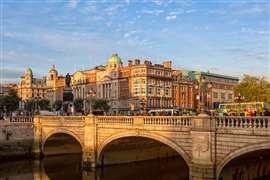What to do in Dublin
12 February 2025
Dublin is a diverse and vibrant city with a wealth of cultural and historic sites.
According to www.ireland.com,“Dublin’s contemporary life melds beautifully with the past on its colourful, vibrant and historic city streets where red-brick buildings, Georgian beauties and modern gems all jostle for attention.”
“Strolling around Dublin is the still best way to get to know it, from the ancient old streets around Christ Church, to the 18th century grandeur of Merrion Square.”
 Dublin. (Image: spanishjohnny72 at AdobeStock).
Dublin. (Image: spanishjohnny72 at AdobeStock).
Literature on tap
As Ireland.com points out, for literature fans there are plenty of options. The James Joyce Centre runs weekly Joycean-themed walking tours, with stops including Joyce’s alma mater, Belvedere College.
“Home to a legion of famous authors and playwrights including Oscar Wilde, Bram Stoker and George Bernard Shaw, it’s no wonder Dublin is a UNESCO City of Literature.”
Apart from the Museum of Literature Ireland, visitors can enjoy the Yeats exhibition at the National Library, and the James Joyce Tower & Museum.
As Ireland.com adds, the Trinity College Dublin is a beautiful university campus dating back to 1592, with beautiful cobbled squares and the Old Library and the Book of Kells.
“History buffs should visit Kilmainham Gaol to hear tales of Ireland’s foremost political prisoners. And both St Patrick’s and Christ Church Cathedrals are must-sees for pilgrims.”
Free museums
According to Visit Dublin, there are no less than 11 museums in Dublin, with all of them being free to visit.
“You’ll find three branches of the National Museum of Ireland, the country’s most important cultural institution, as well as Ireland’s most prominent galleries, which don’t cost a cent to explore. You can even visit the president’s official residence for free.”
You can also take a Viking journey through the city, says Visit Dublin. “Dublin wouldn’t be what it is today without the impact of the Vikings, although our ancestors might beg to differ.”
“The Scandinavian warriors arrived in longboats in 795 AD and ruled for almost three centuries, before being defeated at Clontarf. You don’t have to look too far to see the marks left by these fierce invaders.
“Christ Church and Wood Quay are the two main Viking settlements in Dublin, and a good place to kick off a trip back in time. Here are our top picks to get you started on your voyage of discovery.”
Georgian history
The Georgian era is also on full display in the city. According to Visit Ireland: “Dublin’s Georgian heart is so beautifully intact that you might find yourself feeling as if you have stepped back in time.
“18th century Dublin was one of Europe’s largest cities and its predominant style known as ‘Georgian’ after the four Hanoverian kings of England, all named George.
“Elegant residences and grand civic buildings combined to give an appropriate grandeur to a city looking to make a mark on the European stage.”
This list of Georgian sites by architecture writer Gemma Tipton, winner of the Arts Council’s Critic’s Bursary for her architecture writing, is a good place to start.
- Merrion Square
- The Merrion
- Leinster House
- Áras an Uachtaráin
- Marlay House
- 14 Henrietta Street
- Custom House
- Bank of Ireland Cultural & Heritage Centre
- Museum of Literature Ireland (MoLI)
- More Georgian architecture
For many more tourist opportunites, visit Ireland.com and Visit Dublin




